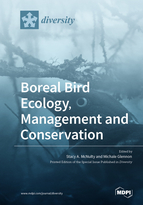Boreal Bird Ecology, Management and Conservation
A special issue of Diversity (ISSN 1424-2818). This special issue belongs to the section "Animal Diversity".
Deadline for manuscript submissions: closed (30 November 2020) | Viewed by 30977
Special Issue Editors
Interests: forest ecology; phenology; vertebrate ecology; exploration of long-term changes; biodiversity conservation and relationship of human land use planning; recreation and forest management to ecosystem function in the northern forest
Interests: effects of land use management on wildlife populations; impacts of residential development on wildlife; recreation ecology; ecological integrity; impacts of climate change on boreal birds
Special Issue Information
Dear Colleagues,
A recent study in Science reported a 29% decline in the North American bird population over 50 years. The loss of almost 3 billion birds is mirrored in Europe and indicates a widespread ecological crisis that may have resulted from loss and degradation of habitat, especially due to agricultural intensification and urbanization. In the Americas, Partners in Flight lists many Temperate Breeders of High Tri-National Concern (e.g., Bicknell’s Thrush, Olive-sided Flycatcher, and Canada Warbler) at risk from habitat loss, contaminants, exotic species, climate change, and threats on their breeding, stopover and wintering grounds. The aim of this Special Issue titled “Boreal Bird Ecology, Management, and Conservation” is to present the current state of knowledge on boreal bird diversity, ecology, management, and conservation. As an important component of boreal habitats, the taxonomic and functional aspects of the avian community are key to conservation measures and can indicate effects of anthropogenic activity on boreal habitats worldwide. We invite you to contribute to this Special Issue of Diversity.
Prof. Stacy A. McNulty
Dr. Michale Glennon
Guest Editors
Manuscript Submission Information
Manuscripts should be submitted online at www.mdpi.com by registering and logging in to this website. Once you are registered, click here to go to the submission form. Manuscripts can be submitted until the deadline. All submissions that pass pre-check are peer-reviewed. Accepted papers will be published continuously in the journal (as soon as accepted) and will be listed together on the special issue website. Research articles, review articles as well as short communications are invited. For planned papers, a title and short abstract (about 100 words) can be sent to the Editorial Office for announcement on this website.
Submitted manuscripts should not have been published previously, nor be under consideration for publication elsewhere (except conference proceedings papers). All manuscripts are thoroughly refereed through a single-blind peer-review process. A guide for authors and other relevant information for submission of manuscripts is available on the Instructions for Authors page. Diversity is an international peer-reviewed open access monthly journal published by MDPI.
Please visit the Instructions for Authors page before submitting a manuscript. The Article Processing Charge (APC) for publication in this open access journal is 2600 CHF (Swiss Francs). Submitted papers should be well formatted and use good English. Authors may use MDPI's English editing service prior to publication or during author revisions.
Keywords
- biodiversity distribution and abundance
- biogeography and phylogeography
- boreal birds
- climate change
- conservation
- extinction risk
- refugia, taxonomy, and systematics
- temperate/boreal ecotone







